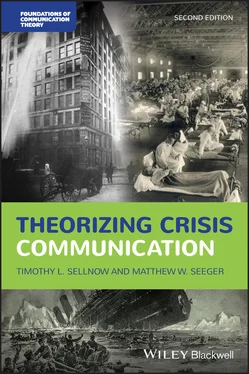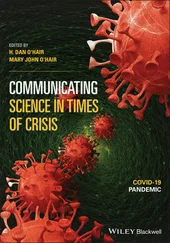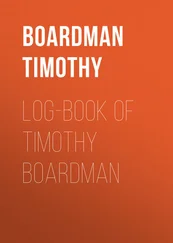Table 3.2Warning Stages and Actions.
| Stage |
Activity |
Question |
Outcome |
| 1 |
Risk identification |
Is there a real threat that I need to pay attention to? |
Threat belief |
| 2 |
Risk assessment |
Do I need to take protective action? |
Protection motivation |
| 3 |
Protective action search |
What can be done to achieve protection? |
Decision set (alternative actions) |
| 4 |
Protective action assessment and selection |
What is the best method of protection? |
Adaptive plan |
| 5 |
Protective action implementation |
Does protective action need to be taken now? |
Threat response |
| 6 |
Information needs assessment |
What (additional) information do I need to answer my question? |
Identified information need |
| 7 |
Communication action assessment and selection |
Where and how can I obtain this information? |
Information search plan |
| 8 |
Communication action implementation |
Do I need the information now? |
Decision information |
Source: Lindell and Perry (2004). Reproduced with permission of Sage Publications Inc. Books.
According to Lindell and Perry (1992), stage one, risk identification, concerns the basic assessment made by a receiver asking, “Does the threat exist?” This is a basic stimuli awareness step. The receiver receives some information about a risk through a number of possible channels (sirens, media reports, word of mouth) and then may consider this information in relation to his or her own risk factors. The reach or the width of diffusion of a warning message is thus a critical variable in this process and is affected by available channels, intensity of the message, and patterns of media use, among other factors. Upon hearing a warning of flash floods, a person might ask, “Do I live in a flood-prone area?” Risk assessment, stage two, then involves asking if some protection is needed given this risk. Based on stage two, assessments may be made about the kinds of protective actions that could be taken. These stage three assessments will be grounded in the available knowledge of the risk, experiences, and risk attitudes and tolerance. For example, experts often advise that residents take shelter in interior rooms during severe storms, such as tornadoes. Having this knowledge in assessing the risk would be prerequisite to taking the desired action. Action assessment, the fourth stage, then, is in part an assessment of the feasibility of taking protective action. A resident would need to have an interior room and be able to reach the room to follow the expert advice. People living with disabilities or in trailers and the homeless might not have the capacity to comply. In many cases of warnings recommending evacuations, some residents are simply unable to evacuate because of mobility problems, lack of access to transportation, or larger economic issues. One issue related to the H1N1 influenza outbreak was the recommendation that children be kept at home in cases of severe outbreaks. Many working parents noted this action was simply not feasible, as young children could not be left home alone. The fifth stage is implementation of the protective response, the action taken to alleviate the risk. This behavioral outcome, according to the model, is a consequence of the previous steps. The final three stages are communication and information stages and concern access to additional information, where to get information, and how rapidly it is needed. A number of investigations have demonstrated that information seeking is a primary activity in a disaster response (see Spence et al., 2006).
Lindell and Perry suggest that finding a satisfactory answer to these various questions is necessary for individuals to progress toward the subsequent decisional stages. Failure to find an answer stops the progress toward a protective action. Thus, communication of relevant information is critical throughout the entire decisional process, not just at the early warning stages.
The PADM integrates theories of social influence and behavioral choice and is informed by a substantial body of research on how people behave in response to warnings. Lindell and Perry (2004) suggest the model has utility in explaining how people respond to specific warnings and to larger risk awareness and education campaigns. The model has been applied in both contexts.
The PADM is in many ways an extension of Mileti’s framework and is informed by the larger body of research and theory in warning processes and decision making. Lindell and Perry (2011) conducted a comprehensive review of the PADM and noted that it had been applied broadly in three areas: (1) development of risk communication programs, (2) evacuation and modeling, and (3) adoption of long-term hazard modeling.
For example, following the Mount St. Helens eruption, Lindell and Perry (1987) used the PADM to assess the risk communication system. They examined a variety of warning channels, including face-to-face, mobile loudspeakers, sirens, commercial radio and television, NOAA Weather Radio, newspapers, and telephones. Multiple channels increased width of distribution. The more specific warning messages increased public response, as did more familiar sources. The more knowledge citizens had about protective responses, the more likely they were to respond to warning messages.
In terms of evacuation modeling, much of the research has examined the factors involved in evacuation decisions, including timing and preparation. Preparation involves both mental and logistic preparation. Both mental and logistic preparation contribute to the overall time interval, although these factors do not appear to be simply additive as they may occur simultaneously. Lindell et al. (2005) examined evacuation behaviors associated with Hurricane Lili, a 2002 storm that caused great damage to the Caribbean and Gulf Coast, to explore the degree to which the questions posed by the PADM varied by demographic factors. These included age, education, geographic location, and the type of physical structure. They also explored information sources and the larger decisional processes related to evacuations, including the timing of the hurricane evacuation notices and decisions and the time required to evacuate. The results generally supported the PADM’s propositions about hazard perception and decisional processes.
The model has also been used to guide inquiry into hazard adjustment promotion and adoption. Ge and colleagues (2011) surveyed Florida households to assess their expectations of participating in hazard mitigation programs for hurricanes, finding that mitigation incentive adoption expectations were related to the perceptions of hazard intrusiveness and, to a lesser extent, worry. They conclude that hazard managers will be more effective in increasing participation in mitigation promotion programs if they use messages that repeatedly remind people of the likelihood of severe negative consequences of hurricanes. Messages that illustrate the destruction and disruption, for example, may increase participation. These mitigation promotion strategies will increase hazard intrusiveness and overall perception of risk perception.
Other studies have explored the ways in which residents assess the cost of evacuations when facing hurricane threats. Shaw and Baker (2010) explored the relationship between perceptions of hurricane risks and the decision to relocate among Hurricanes Katrina and Rita evacuees. They found that time was an important variable, as perceptions of risk and damage fade, and, consequently, the willingness to pay to obtain protection through actions such as relocation also declines over time. The authors conclude that “results may be consistent with Lindell and Perry’s (2004) PADM, which suggests that information is combined with experience, stimulating actions, though the choice model used here involves only a small subset of features of the PADM” (Shaw & Baker, 2010, p. 184).
Читать дальше












